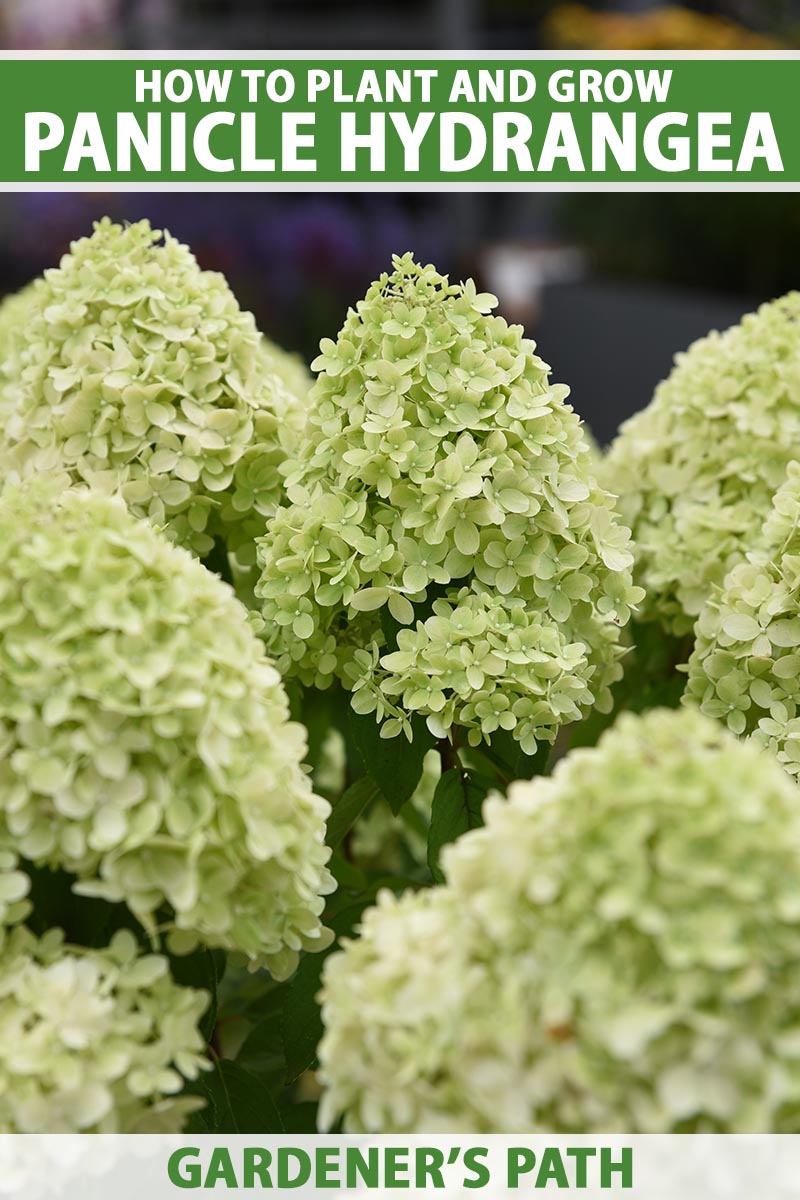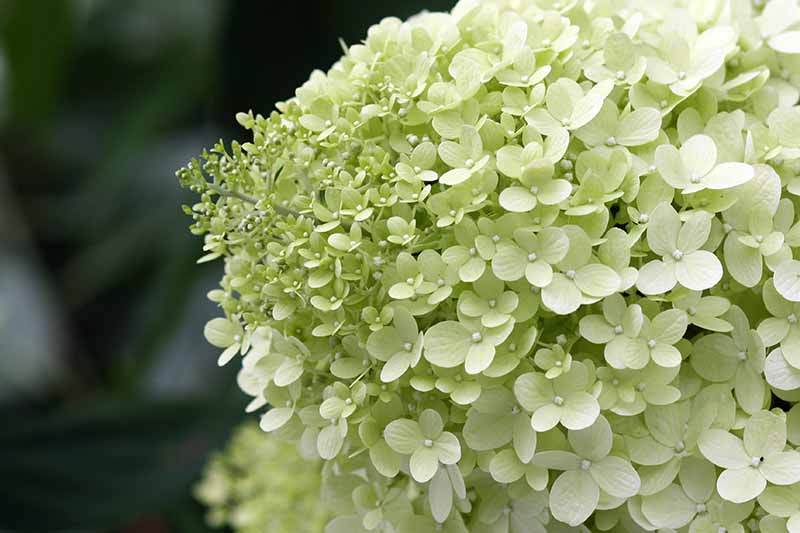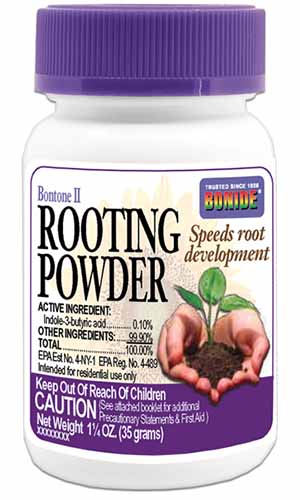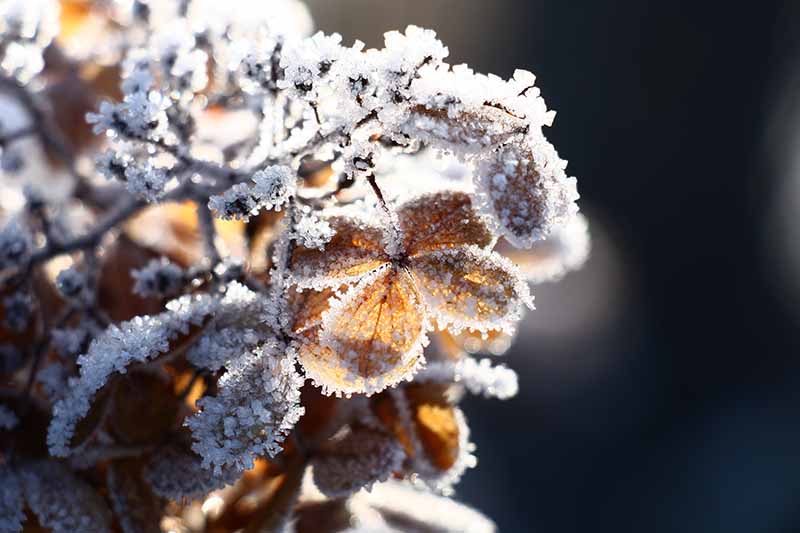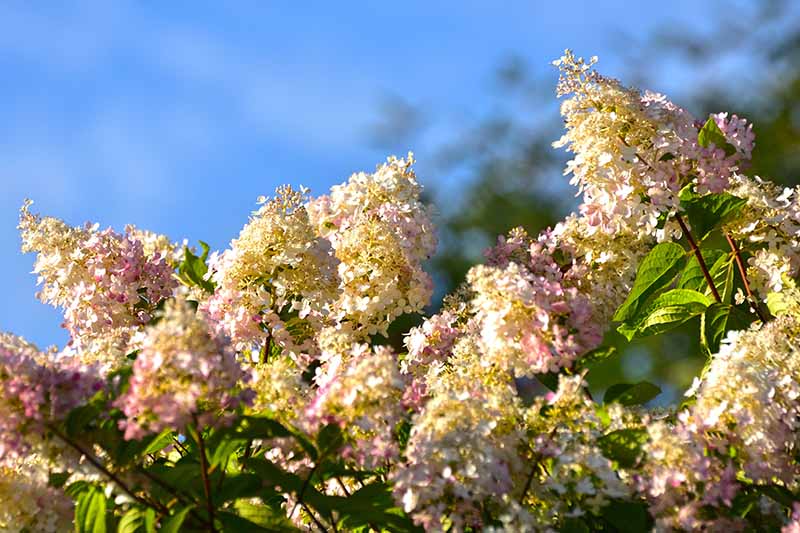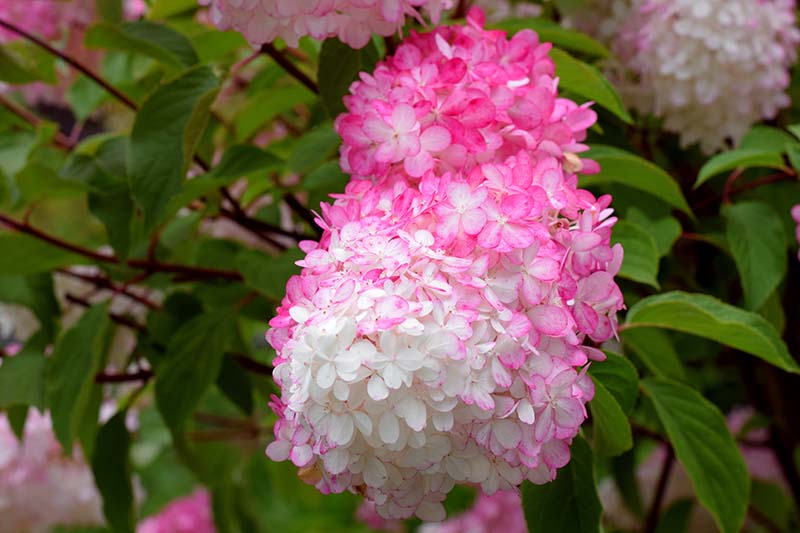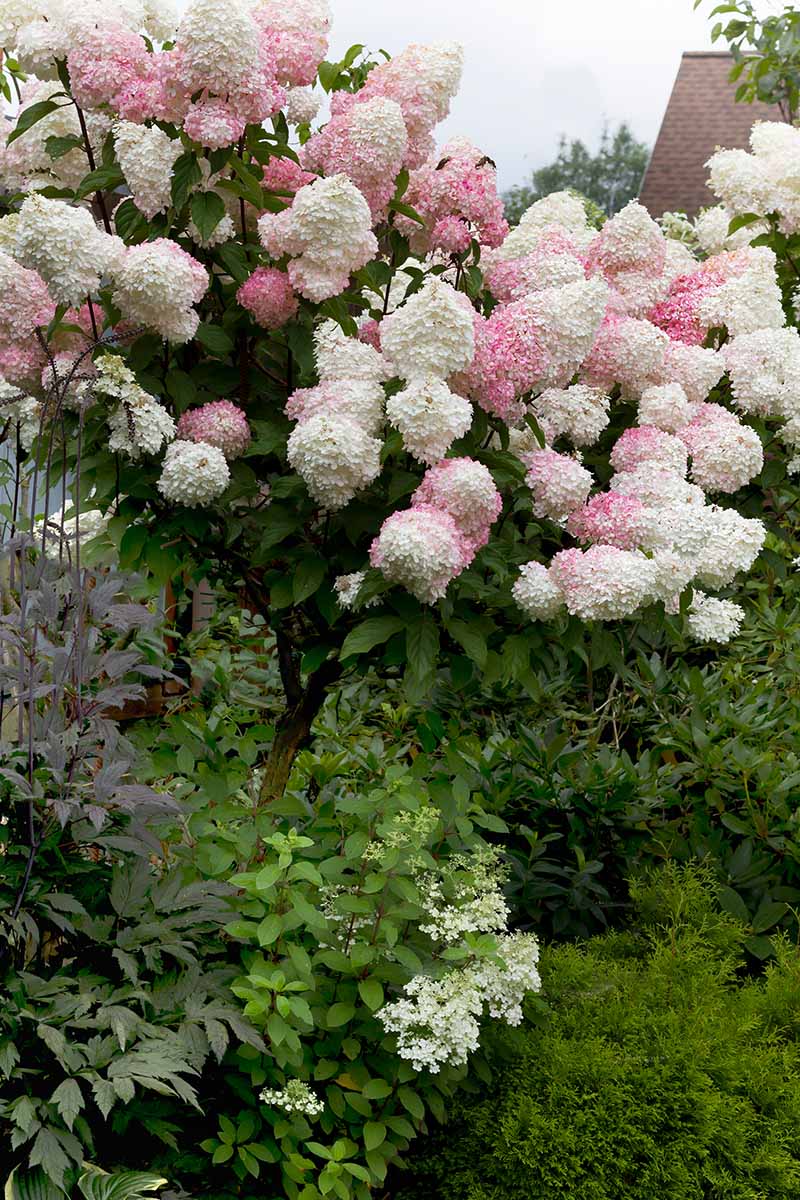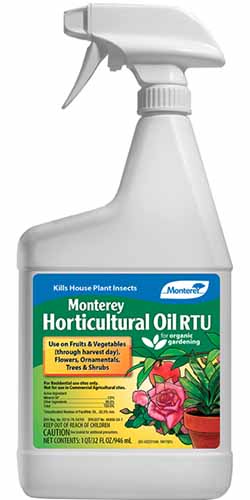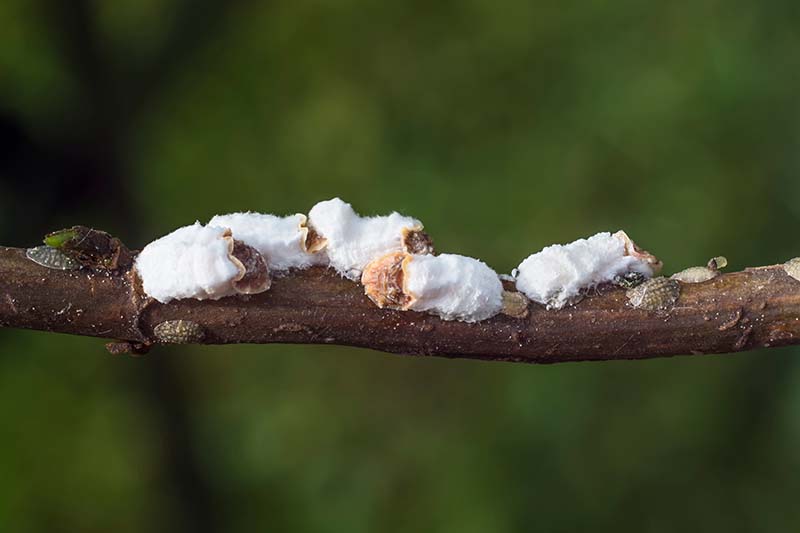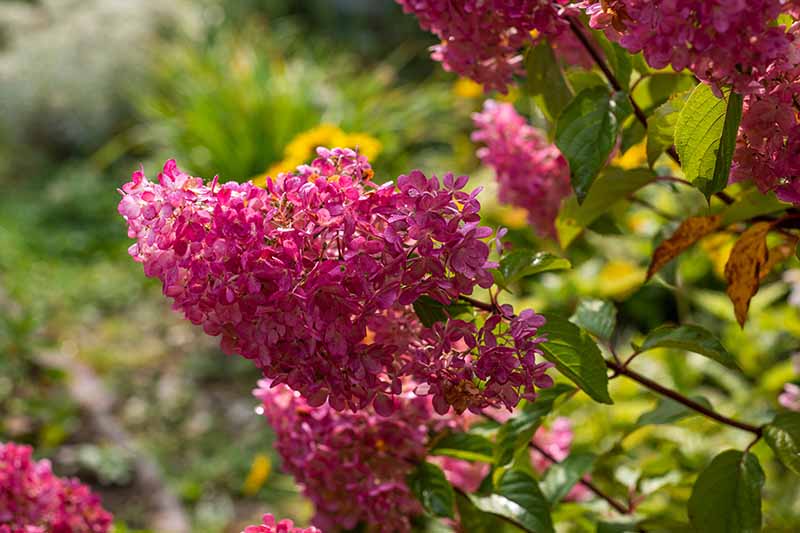Those of us who live in colder climates especially love this bush, but it can grow almost anywhere. It is cold and heat hardy, not susceptible to spring frosts, tolerant of a variety of soils, loves a sunny spot, and is not demanding when it comes to maintenance. As if that’s not enough, she is also gorgeous. We link to vendors to help you find relevant products. If you buy from one of our links, we may earn a commission. The leaves of this shrub also turn from green to shades of yellow and orange in the fall. Are you convinced this is the plant for you? Read on for all the information you’ll need to successfully grow and care for beautiful panicle hydrangeas.
Cultivation and History
H. paniculata is native to cool temperate and subtropical regions of Japan, China, and the island of Sakhalin. ‘Grandiflora’, aka ‘PeeGee,’ was the first panicle hydrangea exported from Japan in 1861. It was extremely popular during the Victorian era, and though it is still the most widely grown type today, its attractiveness sparked the export and development of a wide variety of cultivars, including the well known ‘Limelight.’ When many gardeners think of hydrangeas, they immediately start wondering how they can change the bloom color of their plants by adjusting the soil pH. But that won’t work in this case. The color of the blooms is genetic, and it does change throughout the season, but the change with this species is a response to aging and temperature, not soil conditions. Depending on the cultivar, the bloom color starts out white or cream, and then blushes into a pink or red shade as the days grow shorter and the nights cooler.
Propagation
Panicle hydrangeas are easy to propagate, most easily from cuttings or by layering rather than from seed.
From Cuttings
Taking cuttings is a good way to clone your favorite panicle hydrangea. Snip six- to eight-inch softwood cuttings in late spring or early summer, preferably from a stem that didn’t flower. Remove the leaves from the lower three inches. Place the pot in a warm area with indirect sunlight, and remove the plastic to water when the soil surface is dry. Dip the cuttings into a rooting hormone powder like Bonide Bontone II, available from Arbico Organics. Bonide Bontone II Rooting Powder Stick each cutting into the potting medium two inches deep, one to three per pot, and cover the pot with plastic. Make sure to keep the plastic off the leaves by propping it up with a skewer. Hydrangeas root very quickly, and within two to three weeks the cuttings should resist a gentle pull, meaning fresh roots have pushed into the medium! Keep your rooted plants indoors or in a greenhouse through their first winter. The next year, take the plants outside for the spring and summer, and keep them watered. Bring them back inside again or to a protected area prior to the first frost. You can confidently plant them out in the garden in their third year, either in the spring or fall. Learn more about how to grow hydrangeas from cuttings in our guide.
By Layering
Choose a healthy branch from the outside of the bush, and bend it to test if it will reach the ground. Pick off the leaves where the branch will touch the ground. Scrape the branch lightly with a knife in the area that will make contact with the earth to remove some bark. If you want to speed things up, sprinkle the scraped area with some powdered rooting hormone. Dig a three-inch-deep trench in the soil. Bend the branch gently to the ground, and place it into the trench, weighing down the end with a rock or something heavy. Cover the branch with soil, leaving the tip exposed. Besides occasionally watering, leave it alone to allow roots to develop and new leaves to emerge. Upon signs of rooting and new growth, you can cut the branch away from the parent bush. Separating the new plant from the parent plant can be a shock to the new plant, so leave it in the ground for a few more weeks until it has grown at least four inches tall. At this point, you can dig it up for transplanting.
Transplanting
When you’ve selected your location, dig a hole slightly deeper and wider than the pot size of your transplant. Do not amend the soil with compost or fertilizer. Simply plant it in the natural soil, backfill with loosened soil, and cover the soil surface with a two- to three-inch layer of bark mulch, leaving two inches of space around the crown. This is especially important in cold areas, as the mulch will help protect the roots over the winter. Water it in well.
How to Grow
Panicle hydrangeas are relatively easy to grow, especially once they are established. They are the most heat and cold tolerant of all hydrangeas, so if you live in a cold growing zone where most other hydrangeas would suffer through the winter, this might be your plant! Winter temperatures as low as -22°F are no problem for them. Most are hardy in Zones 3 to 8, and some varieties may be grown in Zone 9 as well. Panicle hydrangea does well in both full sun and partial shade. But give it too much shade and the bush will produce fewer of the big beautiful flower clusters, plus the flowers will fade from white to a muddy color rather than taking on a bright, pure pink or red hue. Don’t plant them too close together either, since these plants can reach a height of eight to 15 feet and spread from six to 12 feet wide, depending on the cultivar. Provided the soil is well draining, panicle hydrangea is relatively tolerant of a variety of soil conditions. It prefers mildly acidic soil and will tolerate slightly alkaline soil. A pH range of 5.8 to 7.0 is ideal to prevent nutritional issues, and fertile soils are best. For the first year or two after planting, water regularly to help it to become established. Once established, panicle hydrangea is relatively drought tolerant. However, regular watering, especially during flowering and periods of hot and dry weather, will result in bigger flowers, and more of them. If the soil is dry three inches down, water well. This plant will do well without additional fertilizer, but if you want your shrub to grow a little faster than it might otherwise, you may apply a balanced fertilizer such as one recommended for roses annually in the spring. Too much fertilizer, or a fertilizer high in nitrogen like those intended for use on lawns, will result in growth that is too fast, and the stems will be too weak to bear the weight of the massive clusters of blooms. Plus, excess nitrogen encourages vegetative growth (stems and leaves) over reproductive growth (flowers).
Growing Tips
Plant in a full sun location.Do not add compost or other amendments at planting time.Water deeply when soil is dry to three inches down.
Pruning and Maintenance
These shrubs bloom on new wood. To encourage the growth of stronger stems and better blooming – and to keep the shrub shapely – you may choose to prune your plant in the late fall or early spring. Only prune the plant when it is dormant. You can tell this is the case if all the leaves have fallen off and have been off for at least two weeks in the fall, or in the early spring before green growth appears. If you prune too late in the spring, you may be pruning out new buds and you won’t get any flowers! Cut the plant back to one-third of its height, and thin out spindly stems, unsightly side branches, dead branches, and any areas that show signs of disease. You can prune out dead or diseased branches at any point to avoid disease spread, if you notice them at other times of year as well. H. paniculata can be trained into a tree, and many nurseries offer tree forms of popular cultivars. Before the first frost of winter, add an extra inch of mulch to help protect the roots during the cold season.
Managing Pests and Disease
Fortunately, serious pests and diseases that affect H. paniculata are limited. But no plant is completely immune to hungry animals and insects, so here are a few to look out for.
Firelight
Boasting strong stems holding up the big creamy white panicles that change to a vivid red, this variety is large, reaching heights of seven to eight feet. ‘Firelight’ It’s available at Nature Hills Nursery both in tree form and as a regular bush in one-quart or #3 containers.
Limelight
If you live in cooler zones, the blooms of this popular variety will start out as a lime-toned white, otherwise the blooms may initially be more of a creamy white. Later in the season, the blooms turn deep pink. ‘Limelight’ This is a tall variety, growing six to eight feet. Hardy in Zones 3 to 9, this cultivar is available at Nature Hills Nursery in one quart, #2, and #3 containers.
Little Lime
Growing three to five feet tall and wide, the sturdy stems of Limelight’s little brother hold up the big lime-colored blooms very well. The vibrant color turns pink and then burgundy as the season progresses. ‘Little Lime’ Plants are available as regular shrubs in one quart, #3, and #5 containers and in tree form in a #5 container from Nature Hills Nursery.
Little Quick Fire
Growing to a diminutive three to five feet tall and wide, this variety explodes in the early summer with oversized creamy white panicles, which turn to a deep pink during the summer. ‘Little Quick Fire’ Plants in quart-size, #2, and #3 containers are available from Nature Hills Nursery.
Strawberry Sundae
If you’re looking for a smaller strawberry-toned variety, this three- to four-foot-tall by four- to five-foot-wide cultivar blooms in creamy white that transitions to rosy pink and strawberry red, also showcasing bicolor blooms. ‘Strawberry Sundae’ Find ‘Strawberry Sundae’ in #3 containers at Nature Hills Nursery.
Vanilla Strawberry
With sweet, fluffy flower clusters that change from white to pink to pinkish-red, and sometimes an attractive two-toned white and pink, this is a very pretty variety that grows six to seven feet tall and four to five feet wide. ‘Vanilla Strawberry’ Plants are available from Nature Hills Nursery in quart-size and #3 containers.
Herbivores
Deer will browse hydrangeas, and you need to watch those graceful herbivores because they can leave you with no flowers later in the season if they nibble the buds. If you have a deer problem in the winter, cover your bush with wire mesh to protect the bark, and you can read more here about other helpful ways to keep deer out of your garden.
Insects
The hydrangea’s nutritious green leaves can be irresistible to a variety of insect pests, including these:
Scale
Scale insects love to visit woody bushes, and this includes panicle hydrangeas. These blister-like insects suck plant juices, and tend to increase in number with each passing year. Monterey Horticultural Oil If these soft insects are infesting your plant, try applying a horticultural oil like this one from Monterey, available at Arbico Organics. Learn more about how to deal with aphids in our guide. If you notice many crawlers (scale insects in the immature stage) early in the season, you might decide to control them with a dose of horticultural oil before they become adults and develop their protective waxy coating. Once they are adults, they are less susceptible to sprays and are much harder to control. Find more tips for combating scale insects here.
Spider Mites
Spider mites love hydrangeas, especially in the summer when it’s hot and dry. Since they are tiny and love to hang out on the undersides of leaves, they are extremely easy to miss – unless they’ve left their fine webs behind, or you notice that the leaves are stippled with yellow spots, that is. Before getting out the horticultural oil, try spraying your shrub with a stiff jet of water from the hose. This will wash the mites off the leaves and onto the ground, where hopefully they will be unable to crawl back up to keep snacking. Learn more about controlling spider mites here.
Disease
Several diseases can affect the stems and foliage of H. paniculata, and many of these affect other species as well. You can read about a variety of diseases that affect hydrangeas and how to deal with them here.
Best Uses
Whether planted as a specimen, in groups, in a hedge, as a border, or in an open woodland garden, this is a showstopping plant. Bonide Copper Fungicide Remove any diseased leaves and treat plants with a copper spray such as this one from Bonide, available via Arbico Organics.
Powdery Mildew
Powdery mildew causes fuzzy white mold on both sides of leaves and is aesthetically unpleasant. Remove infected branches and leaves, and if that doesn’t seem to be helping, you can try applying a copper spray. The late summer blush of color adds interest to your garden well into the fall, and the dry rust or pink-toned beige flower panicles stay over winter, collecting snow prettily. You can use stems as a stunning cut flower, either as a bouquet filler or in a large vase on their own. And, since they dry so well, try using the blooms in dried flower arrangements too. Hardy into Zone 3, and available in a variety of sizes and rosy color combinations, it can have a big impact in a huge variety of gardens – and it has since the 1800s. Do these shrubs grace your garden with their big clusters of blooms? Let us know about your experience with these beauties in the comments section below. And for more information about growing hydrangeas in your garden, have a read of these guides next:
How to Grow Hydrangeas for Big Blossomed BeautyHow to Grow Hydrangea Flowers in Containers7 Reasons Why Your Hydrangea May Not Bloom
